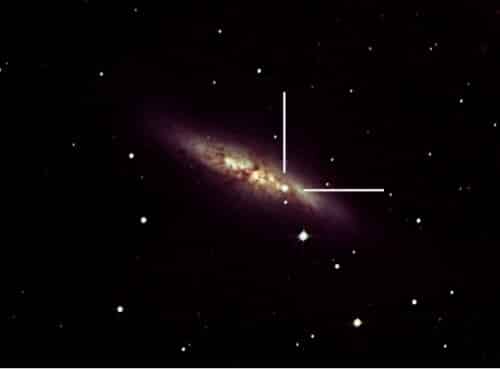At the Wise Observatory of Tel Aviv University, supernovas are observed using an instrument that was only recently purchased by Prof. Zvi Maza from the Department of Astronomy at Tel Aviv University. The new camera allows for high spectral resolution observations (meaning separation into all the colors of the rainbow), and students and faculty have rallied to the effort to track the supernova nightly.

About two weeks ago, a group of students from London discovered a supernova in a galaxy close to us. It quickly became clear that this was an important discovery, since supernovae of this type (Type Ia) are used by astronomers to measure distances in the distant universe, and one so close had not been observed for many decades. The supernova is in the Messier 82 galaxy, 12 million light-years away from us, a galaxy with a high rate of star formation and a significant content of gas and interstellar dust.
The supernova called J2014 is receiving significant attention from most astronomical observatories in the world, and at the Wise Observatory of Tel Aviv University, which is on the rim of the Ramon Crater, an intensive series of observations began. During it, the supernova is watched with the help of a spectrograph that was only recently purchased by Prof. Zvi Maza from the Department of Astronomy at Tel Aviv University and recently installed by Prof. Zvi Maza and research student Micha Engel. The new camera allows for high spectral resolution observations (meaning separation into all the colors of the rainbow), and students and faculty have rallied to the effort to track the supernova nightly.
Dr. Dobi Poznansky of Tel Aviv University's Department of Astronomy, who is leading the project, explains: "What excites me especially is that observations of this supernova allow us to study not only the supernova itself but also the material between it and the observer, since it swallows part of the light that passes through it. This way we can learn about the environment in which it exploded."
The attached photo was taken on January 28, 2014 with the smallest of the three telescopes at the observatory, and shows the supernova - the new star - inside its galaxy.
For a previous article on the subject:

3 תגובות
Did Prof. Zvi Maza purchase the device with his own money?
Israel can improve its observation capabilities, if it launches a telescope into space. For this purpose, an island in the Indian Ocean can be bought/developed and a launch facility built there (or launched from a rig/ship).
If there will be a technological incubator in Chupza Ramon that will focus on space research, on space technologies, Mitzvah Ramon will be the "city of the stars" - Israel's space center.